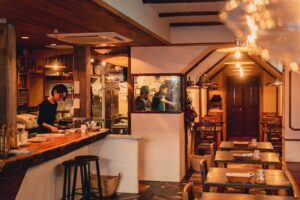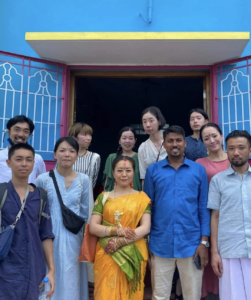Tadka, a South Indian restaurant in Kyoto run by a Dai Okonogi, delivers lip-smacking South Indian fare to your plate.

Tadka, a restaurant in Kyoto, Japan, led by Dai Okonogi, has been authentically serving South Indian flavours since 2012. (Supplied)
A golden-brown dosa, crispy and tempting, takes centre stage on a plate. This delicious offering is accompanied by a variety of freshly made chutneys and a steaming cup of fragrant sambar.
Adjacent to this, a platter of warm keerai vadai, flavourful Chettinadu kuzhambu, comforting guddu pulusu, and a perfectly cooked kal dosai eagerly await their turn to delight your taste buds. To conclude, a rich and aromatic cup of filter coffee provides a comforting finish.
These scrumptious offerings might immediately remind you of a classic South Indian dining experience, but we’re not talking about just any South Indian restaurant.
Tadka, a restaurant in Kyoto, Japan, led by Dai Okonogi, has been authentically serving South Indian flavours since 2012.
Ever since an X (formerly Twitter) user shared their experience on the social media platform, the restaurant has been attracting a surge of Indian customers. South First takes a closer look and explores the restaurant’s flavourful secrets.
Tadka’s journey began as a small eatery, with Dai managing everything, from preparing dishes to running the restaurant. However, operating as the sole manager had its limitations, compounded by the high costs and taxes in the Japanese restaurant scene.
But Dai had a dream. “I wanted to expand and offer a wider range of South Indian cuisine and improve the quality,” he shares.
I visited this kick-ass south Indian restaurant called Tadka in Kyoto, Japan. Tadka is owned and run by Japanese people. They visit Chennai once every 6 months, learn new dishes, practice it to perfection and add it to their menu. pic.twitter.com/rDmBn4JbIC
— Prasanna Karthik (@prasannakarthik) October 29, 2023
His journey towards this dream led to a serendipitous encounter with chef Manikandan in Chennai’s Savya Rasa.
“I was so impressed by the food Manikandan made. I reached out to him right then and there, asking if he’d be willing to come to Japan. Without hesitation, he agreed! he played a pivotal role in helping me realise my visions,” shares Dai. Soon, Manikandan became an integral part of Dai’s restaurant, bringing invaluable expertise and fresh ideas to the table.
“We owe a great deal of our success to his contributions,” Dai gratefully acknowledges.

Tadka was started in 2012. (Supplied)
In 2021, Dai opened his second restaurant, Tadka 2, conveniently situated near Tadka 1.
In this new venture, Manikandan primarily takes the helm during dinner service, while Dai continues to oversee Tadka 1, serving breakfast and lunch.
Dai’s fascination with Indian cuisine, however, began in 2001 when he developed a deep passion for crafting curry from scratch, experimenting with a medley of spices.
“In Japan, the norm is to use ready-made cube-type masala mixes for curries. My journey started with a struggle to perfect homemade curry, which eventually led me to work at Indian restaurants in Kyoto and Aichi for a decade. During this time, I dedicated myself to mastering the intricate art of Indian cooking,” reveals Dai, hailing from Aichi.
Despite his tenure at North Indian establishments, his heart gravitated towards South Indian cuisine.

In 2021, Dai opened his second restaurant, Tadka 2. (Supplied)
“I found solace in its lighter and less creamy flavours. South Indian cuisine harmonised beautifully with our staple food – rice – and that’s what initially drew me in,” he recalls.
And soon, the focus of his restaurant shifted towards the authentic flavours of South India.
But why is a South Indian eatery named ‘Tadka’ (a Hindi word meaning tempering)? we ask.
“In the beginning, I wasn’t certain if our guests would enjoy South Indian food. So, I also served North Indian dishes that I was familiar with. Our customers had already associated us with Tadka, making it a memorable and easy-to-pronounce name. So, we decided to keep our beloved moniker,” he explains.
For Dai, introducing South Indian cuisine to the Japanese palate has been a challenging yet rewarding endeavour over the past 11 years, it seems.
“We’re passionate about changing the perception that Indian food is all about naan. Besides, our restaurant is founded on two core principles: ‘Open the door to a new world through South Indian food culture’, and ‘We are what we eat’,” he shares.
With a predominantly Japanese clientele, many were initially unfamiliar with the concept of dosas and idlis. The process of making the South Indian staples remains an interesting point of discussion, he observes.
“To pique our customers’ interest, we began with a unique twist, offering cheese dosa, somewhat similar to the Italian pizza. This approach helped introduce our patrons to the world of dosa. Fast forward to today, and it’s heartening to see that now everyone enjoys our masala dosa!” he enthuses.
“We also want to promote health and sustainability through our choice of organic, locally sourced ingredients, free from GMOs, artificial colours, and MSG. Everything here is homemade with love,” he says.
The essence of South Indian cuisine lies in its unique taste and flavours, which vary from region to region. At Tadka, one dish that truly represents this essence is the slow-cooked, lentil-based sambar.

Dai’s fascination with Indian cuisine began in 2001 when he developed a deep passion for crafting curry from scratch. (Supplied)
“In terms of flavour variety, sambar is an excellent representation, as it offers a balanced blend of arusuvai (six tastes) that are characteristic of South Indian meals. We are particularly fond of the sambar and chutney from Tamil Nadu, especially around Madurai. In Madurai, you’ll find a wide range of chutney varieties made from various vegetables and herbs, which we’d like to incorporate using Japanese ingredients,” he elaborates.
Currently, Tadka collaborates with an importer for most of their spices and ingredients. Nevertheless, when the restaurant was initially launched, even sourcing curry leaves was a challenge.
“We began cultivating curry leaves at home six years before our restaurant’s opening!” he says.
While Tadka’s primary focus is on Tamil food, Dai ensures that the flavours of the entire southern belt of India shine through the menu.
From pachakari ishtew, nallakaram guddu, ulli vada to Goan dal tadka, they prepare it all. Tadka 2 plays host to special pop-ups, serving food on traditional banana leaves during festivals like Pongal, Vishu, and Onam, providing a unique dining experience.
“When it comes to South Indian food, chef Manikandan has had a significant influence on our offerings. My friend Mr Atreya’s mother, Shelly from Kochi, and others from Chennai have also played a role in shaping our menu,” shares Dai.
Tadka remains true to its authentic South Indian identity by upholding the tradition of encouraging customers to enjoy their meals with their hands.

As you immerse yourself in the act of hand-eating, it becomes an intimate connection between you and the food. (Supplied)
“Eating with your hands offers a creative adventure. Particularly banana leaf meals, allow you to blend and match ingredients to craft your unique flavours. It’s an enjoyable one-of-a-kind experience, likely unmatched anywhere else in the world,” he gushes.
“In these moments, as you immerse yourself in the act of hand-eating, it becomes an intimate connection between you and the food. We aim to share this exceptional experience with our customers,” he shares.
Sourcing ingredients like fresh coconut, curry leaves, and tamarind has indeed posed challenges for Dai. Nevertheless, he has been resourceful in finding these key components. “In certain instances, we’ve had to make adjustments when faced with ingredient unavailability,” he says
Tadka now sources its curry leaves from India, but there’s a growing trend among farmers in Japan to cultivate them as well.
“However, during the winter, the leaves in Japan tend to droop, so imports from India are relied upon. Until about four years ago, Tadka could only obtain Tamarind from Thailand, which had a slightly sweeter taste compared to the Indian variety. Nowadays, we source it from India to maintain authenticity,” he shares.
Operating a South Indian restaurant requires offering a variety of dishes, both for vegetarians and meat lovers. Dai ensures that the restaurant caters well to its diverse clientele.
“A majority of Japanese people have a meat-based diet. This divergence in dietary choices can sometimes lead to challenges, particularly for vegetarians or vegetarian Indian visitors to Japan. When some customers visited Tadka, they expressed a preference for exclusively vegetarian offerings,” he shares.
To address this, Tadka 2 introduced a distinctive menu item known as Poricha saiva meen kuzhambu from Chettinad. This addition, among others, provides an appealing option for those seeking vegetarian Indian cuisine, ensuring a more inclusive and satisfying dining experience.
Similarly, accommodating dietary preferences, including vegan options, is a crucial component at Tadka. “Many vegetarians in Japan are also vegan. We make every effort to cater to their needs,” he highlights.
Dai has been a visitor to the Dravidian land on multiple occasions.
“Last year, the entire team visited South India to share a significant moment in the life of chef Manikandan, as he married his Japanese partner. It was a heartwarming experience,” he reminisces.
While creating memories with his team is something he cherishes, on a personal level, Dai is a lover of the temple prasadhams of the south.

Dai Okonogi with his team in Tamil Nadu. (Supplied)
“It’s challenging to express just how joyous it is. Whether it’s at Tirumala, Jagannath, or the serene Ramana Ashram, these moments of spiritual connection hold a special place in my heart,” he shares.
Tapping on his experiences here, he has been making cross-cultural connections through food back in Japan. For approximately a year and a half, they have employed the donation system of Indian ashrams and temples for their lunches on full moon days.
“I believe it was an uncommon practice in Japan, but it had a great impact on some people. They were moved to tears, not because they couldn’t afford a meal, but because they felt they were partaking in a gift from God. This memory holds a special place in my heart,” he shares.
“Tadka’s primary objective isn’t expansion; it’s the commitment to maintaining quality,” says Dai.
If any expansion is considered, it will be contingent on meeting their stringent standards, which includes securing a dependable chef, like Manikandan.

The walls at Tadka 1 are adorned with images of gods and goddesses from Hinduism. (Supplied)
“I want to introduce age-old South Indian recipes that are prepared over a wood fire and using earthenware, the traditional way. We are exploring the possibility of this. But we have to ensure access to the right ingredients,” he says.
While traditional culinary tools might not be readily available in Japan, Dai diligently seeks what can be imported. One such he is keen on acquiring is the Ammikal or Silbatta, despite its heavy nature.
For Dai and the Tadka team, the journey into South Indian culture and language has been a step-by-step process.
Learning can be a challenging task, especially in areas like Kyoto, where such resources are scarce.
However, the team is steadily making progress through interactions with chef Manikandan and Tamil friends in the neighbourhood.
Their interactions have been instrumental in cracking the nuances in taste perceptions that distinguish Japanese and South Indian cuisines.

As a symbol of his journey to Tamil Nadu and the love he shares for the culture, Dai has even picked up some Tamil words: Vanakkam (Hello), Nandri (Thank you), Podhuma? (Is this enough?), and Pathu poitu vaanga (Have a safe journey).
With a chuckle, he adds, “But I’m eager to learn more. Kathu tharingala? (Can you teach me?)” as he signs off, poised to brew a fragrant cup of filter coffee.
To be part of Dai’s culinary journey, visit Instagram @Tadka

Jul 26, 2024

Jul 26, 2024

Jul 26, 2024

Jul 26, 2024

Jul 26, 2024

Jul 25, 2024